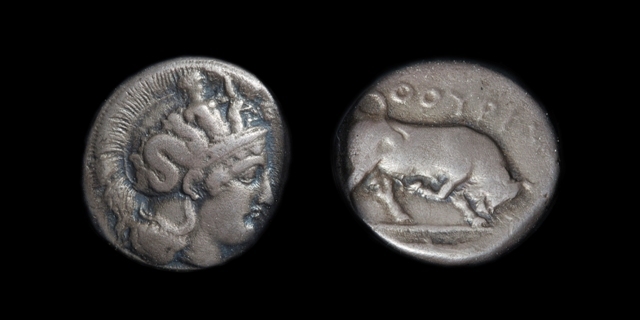Thurii, Lucania, Silver Stater
Dublin Core
Title
Thurii, Lucania, Silver Stater
Subject
Thurii, Lucania (Italy). Silver Stater, ca. 400-350 BCE.
OBVERSE: Head of Athena, wearing a crested Attic helmet adorned with a Skylla who is shading her eyes.
REVERSE: bull pawing the ground, facing right, head down. "THOUPIWN" (= Thurion, "of the Thurians") inscribed above. Mullet-fish swimming right in exergue.
OBVERSE: Head of Athena, wearing a crested Attic helmet adorned with a Skylla who is shading her eyes.
REVERSE: bull pawing the ground, facing right, head down. "THOUPIWN" (= Thurion, "of the Thurians") inscribed above. Mullet-fish swimming right in exergue.
Description
The history of Thurii, one of the last Greek settled colonies, starts with the history of the colony Sybaris. Founded in 720 BCE, it was conquered by neighboring Croton in 510 BCE. After several unsuccessful attempts to re-occupy the city, Thurii was founded by the initiative of Perikles in 443 BCE near the remains of the old Sybaris. Home to the historian Herodotus and the sophist Protagoras of Abdera (who was commissioned to write the new city's code of law), Thurii quickly rose to rival its neighbor Tarentum. As a compromise, both cities together founded a new colony, Heraclea, in contested territory in 432 BCE.
This coin bears Athena with a Scylla (part human, dog and snake) adorning her helmet. The Scylla may be a reference to Athena Skyletria or a symbol of prosperity that “looks out for loot.” The bull on the back was a common symbol on the coins of Sybaris. Since river gods were often represented with bull features, both the bull and the mullet, a fish that likes brackish water and was considered a delicacy, may be a reference to the nearby river Krathis.
This coin bears Athena with a Scylla (part human, dog and snake) adorning her helmet. The Scylla may be a reference to Athena Skyletria or a symbol of prosperity that “looks out for loot.” The bull on the back was a common symbol on the coins of Sybaris. Since river gods were often represented with bull features, both the bull and the mullet, a fish that likes brackish water and was considered a delicacy, may be a reference to the nearby river Krathis.
Source
Gift of James and Aneta McIntyre, Hallie Ford Museum of Art, Salem, OR. 2006.010.028
Date
400-350 BCE
Rights
Hallie Ford Museum of Arts
Format
1.990 cm
7.500 gr
7.500 gr
Language
Greek
Type
Coin
Coverage
This item is on view at the Hallie Ford Museum of Art, in the Mark and Janeth Sponenburgh Gallery.
Citation
“Thurii, Lucania, Silver Stater,” Hallie Ford Museum of Art Exhibits, accessed December 28, 2025, https://library.willamette.edu/hfma/omeka/items/show/80.
